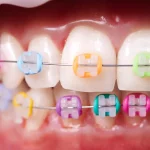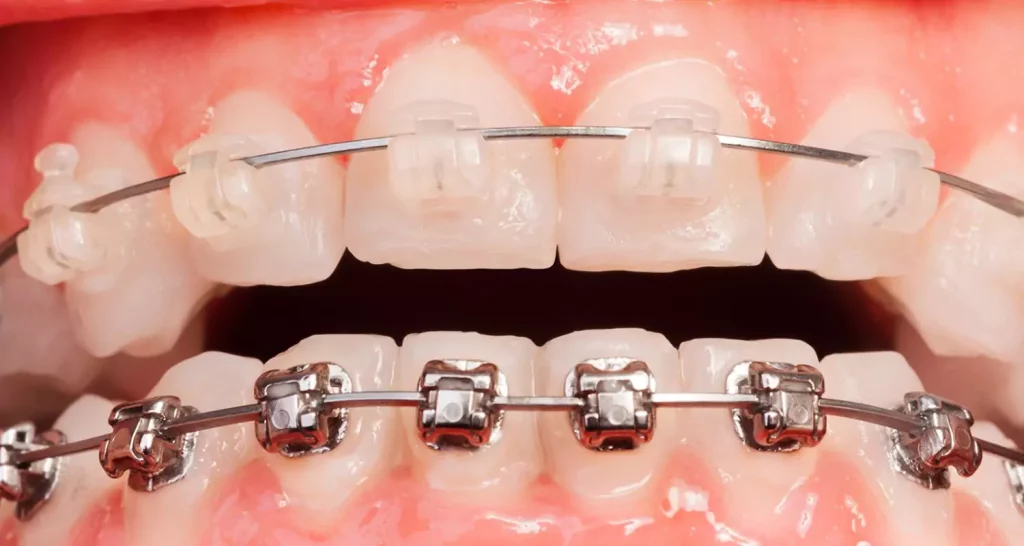Last Updated on: 4th December 2024, 05:14 pm
Main differences between Ceramic vs Metal Braces
In orthodontics, braces are used to correct teeth and bones that are poorly positioned in the mouth, causing problems with the gums and bite. wear of the teeth will affect their functionality and overall aesthetics. Many people seek treatment to correct their dental aesthetics to look better, boosting self-esteem and improving oral health.
Braces are made up of several parts:
- Brackets: the square structures that attach to each tooth
- An archwire that connects each bracket
- Elastic bands that wrap around the brackets and hold the wire in place
We now ask, is better: metallic or ceramic? We will review each one, stating its pros and cons, to help you make a decision.
Advantages and Disadvantages of Ceramic Brackets
These braces, which are transparent or tooth-colored to match natural teeth, are made of porcelain material, making them less noticeable than the metallic variety. They function similarly to metallic braces by addressing teeth misalignment or crowding issues. However, it’s important to note that proper oral hygiene is crucial in preventing cavities caused by braces.
Characteristics

- They are almost imperceptible to the eye, which is why they are the most aesthetic solution on the market.
- The price is high, so they are not accessible to everyone.
- They are comfortable and cause less discomfort than metal braces.
- They require more care because stains are more noticeable given the color.
Advantages
- They are less visible than the metallic ones, due to their translucent or tooth-like color.
- The movement of the teeth occurs a little faster. It takes approximately 18 to 36 months to straighten them, which is better than other methods.
- It is favorable for those with allergies to certain metals.
- They may cause less gum irritation and are less uncomfortable.
- It is possible to choose the color. The metallic option isfixed. In addition, the arch and the bands can be transparent just like the brackets.
- They do not interfere with X-ray diagnostic tests since the metal content is very low.
Disadvantages
- They entail a higher cost, it is estimated to be above the metallic version by $1,000 to $2,000, approximately.
- Because ceramic braces are larger, they may cause more gum sensitivity.. As a result, it is difficult to properly clean around the brackets, causing gum inflammation or recession if the brush does not reach all areas properly.
- They last less time than metal ones since having a solid core, they can fracture or break more easily and will have to be replaced, causing loss of treatment time.
- The removal of the cement or glue causes damage to the tooth enamel surface.
- If care is not taken, the treatment could take longer than for the metal ones. As they are so fragile, it will prolong the overall time.
- They stain easily, so careful brushing is important.
Advantages and Disadvantages of Metallic Brackets
Metal braces are made of stainless steel. They move the teeth to align them correctly. The metal bracket is a fixed orthodontic appliance cemented to the tooth. It functions to transmit forces to align the teeth. They are the most economical method to align teeth and improve your smile.
Characteristics

- They have great durability and adhesion capacity.
- Due to their metallic composition, they are more visible than other types of orthodontics.
- If pieces fall out or break, they are easy to replace.
- They are very resilient and effective, especially when correcting serious problems.
- To improve aesthetics, colored garters can be placed, which draws a lot of attention for children and adolescents.
- They are cheaper than ceramic braces.
Advantages
- It is the oldest system with proven effectiveness over many years.
- They are the most economical option for orthodontic treatment.
- The technique is more resistant than certain types of transparent braces, which tend to break easily. The metallic material makes it very difficult for the brackets and archwires to break.
- It can be an attractive and beautiful option since you can add colored ligatures.
- Being metallic there is no chance of discoloration.
Disadvantages
- If you want the best aesthetics and do not want any metal to show when you smile, this option is the least recommended.
- Like other dental braces, it is possible that the first few days may produce soreness or chafing.
- Being fixed on the teeth, it is important to practice good hygiene.
- It may leave a metallic taste in your mouth. Youget used to it over time, but it could be long-term.
The differences between metallic and ceramic braces
- Aesthetic: Definitely the ceramic or sapphire braces are more aesthetic, making them more desirable than the metallic ones.
- Durability: Metal brackets have an advantage due to their composition. They are better at resisting the adverse conditions of the mouth; however, ceramics with care make them less likely to break. In fact, studies have found that clear/ceramic braces are more than twice as likely to break or fracture than metal braces.
- Adhesion: The adhesion strength of metal brackets is superior to that of ceramic brackets; therefore, they can resist the force of chewing. In some cases, it is preferable to use metal brackets in the lower part of the mouth at the level of the premolars to avoid wear and tear of the dental components.
- Staining or hygiene: Taking into account color, ceramic braces are more likely to stain, so wearers should limit their intake of dark foods and drinks since they may stain or discolor the braces. Hygiene must be meticulous with ceramic braces, while with metallic ones although they require care, they do not stain as easily.
- Enamel wear: If you have ceramic braces on both your upper and lower teeth, enamel wear can be a long-term problem. This when biting or chewing food due to the abrasive nature of the material. Without proper care, this will make your teeth more susceptible to cavities.
- Cost: Ceramic braces are much higher in cost than metal ones, on average. The complete treatment (visits, brackets, facilities and equipment, a specialized dental professional and follow-up) comes between $3,000 and $7,000 while metal braces cost between $1700 and $6000, depending upon the case, timeframe, and location.
- Effectiveness: Metal brackets are definitely more effective due to the greater ease they provide when making three-dimensional movements, especially in complex cases (very rotated or crowded teeth). However, the “skill” and experience of the orthodontist must be kept in mind. Some ceramic brackets with a metal slot and transparent self-ligating brackets compete effectively with metal systems. In a few cases, they may surpass them.
Care of the ceramic brackets
It is preferable that professionals, adults, and university students -who are more conscious of their dental care – use ceramic or transparent braces The more aesthetic appearance favors their status in life.
Tips for the care of ceramic braces:
- Brush and floss after every meal to remove food residue that could cause staining.
- Avoid foods and drinks that leave discoloration. Tomatoes, wine, coffee, tea, soft drinks, or condiments like ketchup and mustard are known to stain teeth and ceramic materials.
- Don’t smoke: it can leave yellow stains on your teeth and all orthodontic components.
- Do not use whitening toothpaste. Whitening agents can make the exposed surface of the tooth whiter than the tooth below.
- Visit your orthodontist regularly. Your orthodontist can replace stained ceramic brackets as needed.
Conclusion
Metal braces have more clinical advantages as compared to the more aesthetic ceramic appliance, as long as they are of good quality.
The use of aesthetic braces is ideal for adults, where appearance is a vital factor. However, special maintenance and the initial installation price must be taken into consideration.
An experienced orthodontist will satisfactorily solve the problem of dental malposition with either of the two systems.
Contact us
If you have any questions about this or other topics, you can contact us at Channel Island Family Dental as well as our Facebook page. We look forward to your visit and we will make a timely diagnosis. Our dentists in Oxnard, Saint Paula, Venture, Newbury Park, and Port Hueneme will be able to guide you towards the best treatment to take care of your health and give you back your best smile.
Bibliography
- Madisha, Lusi. “Difference between Ceramic Braces and Metal Braces.” Difference Between Similar Terms and Objects (Internet). Review on Jun 01, 2018 (consulted on Sep 19, 2022). Available on: http://www.differencebetween.net/science/health/difference-between-ceramic-braces-and-metal-braces/
- Sandoval, Yuliana. Ceramic brackets – Everything you need to know about white orthodontics. Dentaly.org (Internet). Review on Jul 19, 2022 (consulted on Sep 19, 2022). Available on: https://www.dentaly.org/es/ortodoncia/brackets/ceramic-brackets/
- deLeeuw, Anne; Khosravi, Rooz, DMD DMD, PhD, MSD, Orthodontics. Ceramic braces: Pros, cons, and cost. Medical News Today (Internet). Review on Jun 21, 2022 (consulted on Sep 19, 2022). Available on: https://www.medicalnewstoday.com/articles/ceramic-braces#summary
- Jewell, Tim; Frank, Christine, DDS. Ceramic Braces: How Do They Compare? Healthline (Internet). Review on May 17, 2019 (consulted on Sep 19, 2022). Available on: https://www.healthline.com/health/ceramic-braces.



